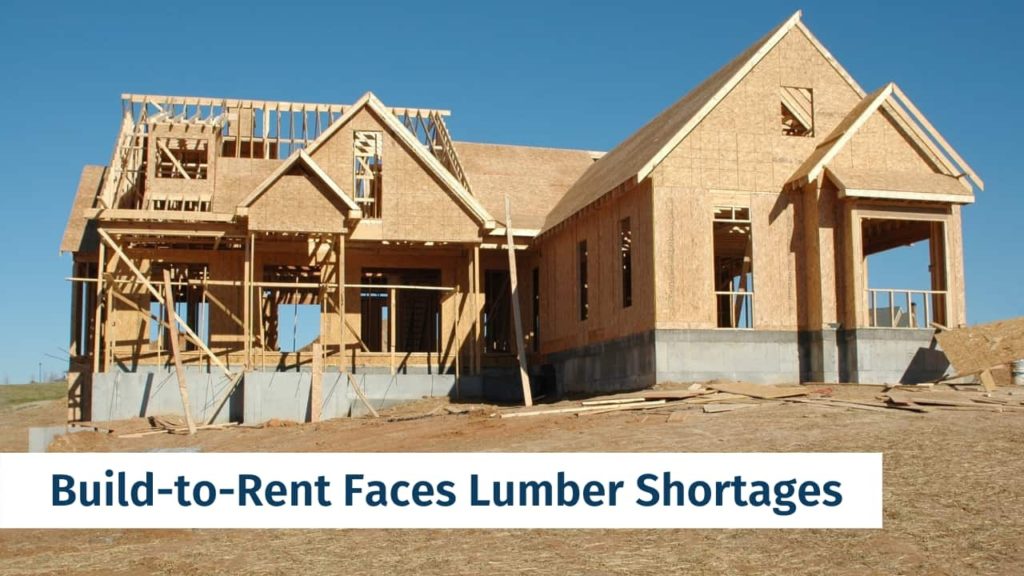
The Demand for Lumber Increases
2020 was a great year for interest rates as home mortgages and construction financing fell. This opened the door for both new and seasoned real estate investors to jump in on the benefits of new construction multifamily. With build-to-rent being an ever-increasing trend over the last few years, this sudden ease of financing has brought both opportunities and challenges.
The cost of lumber has skyrocketed in the last 12 months, and this is something we’d like to address in a bit more detail today.
The Covid-19 pandemic changed our day-to-day lives in a lot of ways. Going into 2020, the demand for new construction was at an all-time high. That demand, coupled with a drop in interest rates has not gone away. One thing that did change, however, is the ability to match this demand.
The pandemic brought with it nationwide shutdowns of lumber facilities supplying the U.S. housing demand. Even as these facilities open up and get back to full functionality, they’re falling behind. This simple principle of supply and demand has brought record prices in the lumber industry.
When government shutdowns first began, there was a temporary lull in construction and remodeling starts. This led to a drop in prices in the spring of 2020. Since then? As businesses started to re-open in June, lumber costs jumped from about $250 per 1k board feet to over $850 per 1k board feet! This sudden leap in demand resulted in some location’s lumber costs going up by as much as 340%+.
“This quarter, 41% of contractors say less availability of building products and materials is a severe consequence of the pandemic, up from just 15% saying the same in Q3.” – U.S. Chamber of Commerce
The Q4 2020 U.S. Commercial Construction Index stated that 71% of contractors say that they face at least one material shortage. This is up from 54% in Q3. The most common material shortage? Wood/lumber. 31% of commercial construction contractors report a shortage of lumber. A 20 point increase from the 11% in Q3.
This same study reports that 83% of contractors are experiencing project delays due to COVID-19. The average share of delayed projects by contractors is 26% and is estimated to drop to 18% in six months.
“The pandemic has exacerbated issues contractors were already facing in availability and cost of materials from tariffs and a shortage of skilled workers. But there’s reason for optimism. More than one in three contractors plan to hire more workers in the next six months, and most see sufficient new business in the coming year. The industry is a positive indicator of where the rest of the economy is going, but it’s likely confidence won’t fully return until companies and workers have the confidence to get back to work safely.” – U.S. Chamber of Commerce Executive Vice President and Chief Policy Officer, Neil Bradley
How does this affect FIG?
As material and land prices increase, some home buyers are forced out of the market and have no choice but to rent. This creates more competition for the limited supply and eventually (usually trailing 12-24 months), rents go upward. Bottom line? While prices are increasing, we expect rents to eventually narrow the income and expense gap over time.
One thing FIG is best known for is a “fixed bid contract.” Once you’re contracted on a property, the price doesn’t change. There are pros and cons to this strategy. If prices for lumber, concrete, land, etc go down, you end up paying more than you would have if you waited. However, if material prices go up, you will own the property for a good amount less than what it would have cost you once completed.
For FIG, this creates a tricky situation. When we set a price for one of our fourplexes, we have to account for the uncertainty of material prices and commit to an overall price that we’re confident we can hit. If we don’t, we take the hit and it comes out of OUR pocket. With lumber being as expensive as it is, we’re now evaluating where prices need to be on future fourplexes to ensure we don’t get caught in the lumber vortex!
We’ll keep you posted on any pertinent details that emerge as the entire market grapples with a lumber shortage. In the meantime, contact your agent on the FIG team with any questions you might have.
Lumber Trends 2020-2021
It’s not just commercial and residential starts that have represented surges in lumber demand. As many shelter at home because of the coronavirus, home renovation projects have gone through the roof. Shortages of wood/lumber are expected to extend into Q2 2021 or longer.
“Lumber futures traded around $800 per 1,000 board feet in mid-January, their lowest level since December 11th as investors unwounded long positions after a rally to above $900 early this month.”

This month, the latest data on housing construction and home sales in the U.S. shows an increase from this time last year. This is a good sign for the near future of home building and commercial real estate.
“Macroeconomic conditions in the US remain murky, however, there are two things that can be solidly stated even at this year part of the year: one is that home builders are reporting difficulty in finding lots for purchase. The other is that there is challenges finding additional workers to hire.
Indeed, the latest US data release shows the 472,500 new residential construction jobs created from May through December 2020 offset the 456,800 jobs that were lost in April and May. As well, for full-year 2020, home building and remodelling added 57,200 net jobs in the US.” – Madison’s Lumber Reporter

“Unstoppable demand over the Holiday Season pushed prices relentlessly higher, for the week ending January 8, 2021 benchmark softwood lumber commodity item Western S-P-F KD 2×4 #2&Btr prices rose to US$944 mfbm, which is up another +$70, or +8%, over the previous week, said Madison’s Lumber Reporter. Last week’s price is +$324, or +52%, more than it was one month ago when it was $620.” – lesprom.com

“Compared to the price one-year-ago, of US$402 mfbm, last week benchmark softwood lumber item Western S-P-F KD 2×4 #2&Btr was selling for US$944 mfbm which is +$542, or +135% more.”
The table below shows a comparison between recent highs in Fall 2020 and our current high in January 2021. You can compare this with the historical high in the Summer of 2018 and a recent low in 2015.

Sources: Trinity Building Systems, U.S. Chamber of Commerce, Trading Economics, lesprom
